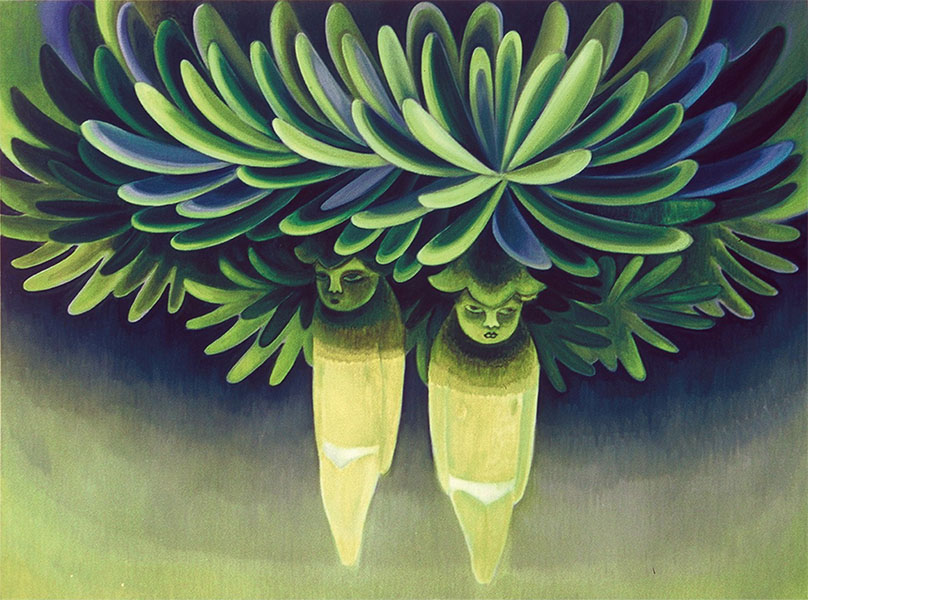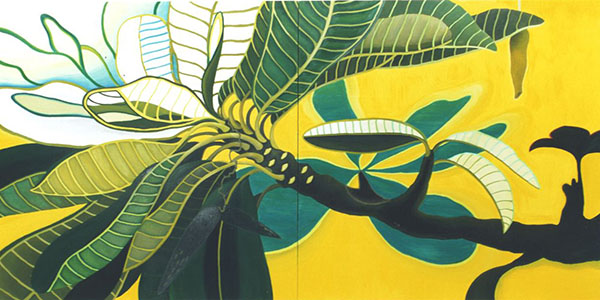Wakwak Tree [ ワクワクの木 ]
2000 年に初めてタイ旅行をして、当時バンコクで滞在制作していた日本人画家を訪ねた。
その時まで興味を持っていなかった東南アジアの国に充満する上座部仏教の空気に圧倒され、美しさの虜になった。
そこで伝説の木の実を描いた仏教画、上半身裸の女性がなるワクワクの木(タイ語ではマッカリーポン)に出会った。
その後、自分の中でイメージを咀嚼してバンコクで見てきたゲイバーの男の子がなる木を描くようになった。
そしてその時もう一つ惹かれたのがLANTOMH(ラントム)という大きな葉を持つ木の姿だった。
初めてのタイ訪問から一年経たないうちに、もう一度タイに渡ってラントムの木や仏塔の絵を毎日描いた。
木の意味やその姿は日本の大山木に似ている。
死者のための木で、寺院や墓地に植えられることが多く、元々は「悲しみ」を表す木だったが、人々にその姿を愛されて(Lee-Rawa-Dee = リーラワディー)と改名され、より親しみやすい存在になった。
洋名はプルメリアといい、キョウチクトウ科の植物である。

ワクワクの木ミクストg o – g o – B A R
“ ひだ( ビロード) ”
2001 / 95.6×1115.3 / o i l o n c a n v a s

ワクワクの木ミクストg o – g o – B A R ”疑惑”
2 0 0 2 / 1 6 2 . 4 x 3 2 4 . 8 / o i l o n c a n v a s
ゲイバーで働いている男の子たちの姿に吊るされているような不条理感を感じ、木からなる仙果の姿に重ねたことがきっかけとなり「ワクワクの木ミクストgo-go-BAR」という一連のシリーズで作品を繰り返し描いてきた。霊的な世界観を持つため、死者のための木というL A N T O M Hの木をモチーフにすることもイメージが一致していた。
近年では「作庭」をテーマに絵を描くようになり、日本の庭木をモチーフにしているので、どの木であるかということにはこだわらなくなっている。ワクワクの木の男の子たちも生命の象徴というような存在であると感じている。

L A N T O M H
2002 / 194×388
o i l o n c a n v a s
ワクワクの木
「中国の東、ワクワク島には不思議な木がある。木には裸体の女たちがぶら下がっており・・・」古くアラビアに残っている人間が生るという伝説の木である。「ワクワク(Wakwak)」とは当時のシナ人が日本を「倭国」と呼び、その音訳がアラビア周辺で「Wakwak」となったのだとされる説もある。(平凡社 中野美代子著「中国の青い鳥」より)
(追記として : 現在もタイ国内ではワクワクの木と大変よく似た不老不死の実マッカリーポンの伝説が広く知られている。 )
Wakwak Tree
“”In the east of China, Wakwak island, there are mysterious trees. Naked women are hanging down from them…” It was an old legend about the trees which bear human beings spoken in Arabia. One of the stories was said that the name “Wakwak” was come from Japanese old name “Wakoku” which Chinese people used to call Japan in the ancient period. Then the sound had translated as “Wakwak” around Arabia. ( reference essay ; “Chinese Blue Bird” written by Miyoko Nakano, Heibonsha library publishing ) (In addition : Even now, there is a story of immortal fruits which is quite similar to the legend of Wakwak tree called McCully-pon (spelling unconfirmed) and it is widely well known among the people in Thailand.)
Series-01: ワクワクの木ミクストgo-go-BAR (w.m.g.)
ワクワクの木の伝説をもとに、木に生る裸体の女性をブリーフをはいた少年の姿(もとのイメージはバンコクのゲイバーで出会った少年たち)に置き換えた。又、タイ王国国内で人々の死に関連し、「哀しみ」の意味をもち、主に寺や墓の周りに植えられるという大きな葉を生やすLANTOMH(現在は良い意味の LEELAWADEE という愛称でも呼ばれている)の木をワクワクの木そのものに見立てた。当初は木に吊るされたような姿で生る少年像に悲しい不自由さや無気力を感じ、同時に私を含め彼らを見つめる周囲の人間達の傲慢を感じ取っていたが、時が流れるにつれ、私は自然の光と葉と共に、愛すべき人間達の姿を描きたいのだという気持ちだけが残った。
Series-o1: Wakwak tree mixed go-go-BAR (w.m.g.)
Based on the legend of Wakwak tree, I had adopted the boys in the white briefs (those who I saw working at the gay-bar in Thailand) to the image of naked women bearing on the Wakwak tree. Also, I had adopted LANTOMH (the trees usually planted around the temples and the tombs in Thailand, in the relation to people’s death with the meaning of “sorrow”, but now they are also called LEELAWADEE as the pleasant name) to the image of Wakwak tree. In the beginning of this series, I felt sadness and powerlessness from the boys by the way of being hung from the trees, and I felt ego from the people watching them including myself at the same time. But now, as the time goes on, it is left only the feeling that I just want to express the natural light, leaves and the lovely existence of human beings together in a same space.
